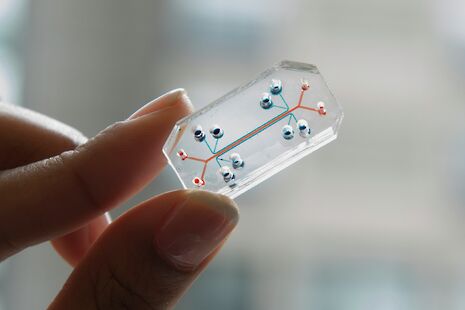Lab rats & computer chips
Judith Zarebski considers the new technologies set to replace animal testing, and the challenges faced by this transition

Animal testing has been a scientific tool for around for 2,500 years and has provided us with countless answers to biological and chemical questions. What started out as dissection to understand complex mammal systems such as the respiratory system is now a massive range of experiments performed on animals, including state-of-the-art “organs” created from co-cultured cells.
There has always been public opposition to animal testing, and laws and regulations to protect animals are not a new invention – with the first UK animal-protecting law dating from the 17th century. Millions of people around the world are working actively today, with the help of NGOs such as Cruelty Free International, to put an end to animal testing altogether. A surge of alternative technologies is now beginning to take place. However, many scientists argue that techniques involving animals are as refined and humane as possible.
The humane treatment of animals is a legal requirement in most countries when using them in an experiment. The UK, for instance, follows the 3R rule when using animals in experiments: reduce the number of animals, replace them with other alternatives and refine the procedures to minimize their suffering. In this way, the use of animals has been said to be reduced to experiments where the harm caused to them is outweighed by the potential benefits. This may include using animals in very regulated experiments to obtain new drugs, vaccines or ensure the safety of chemical products.
These tests can sometimes be beneficial to the animals they are tested on, as over half of the drugs used by vets are derived from medication originally intended for humans. To many, this is a small benefit in the complex grey area of measuring the value of living organisms’ lives.
The number of animals used in laboratory experiments each year is hard to calculate. Regulations of varying leniency have led to a lack of transparency in certain regions across the globe. Some countries do not even have to disclose the number of animals used in research. In Canada for instance, only labs funded by national funding agencies are obligated to disclose that number. The rough global estimate is thought to be in the tens of millions each year – a figure which only includes vertebrates.
The simplest alternative to the use of mice and other lab mammals is the use of less ‘ethically-challenging’ animals with lower cognitive abilities and a less complex nervous system, mostly invertebrates. A movement in research practice from higher sentience animals such as monkeys and dogs to lower sentience animals such as fruit flies has been seen. However, it is tricky to completely make this switch as some complex drugs and tests require a very elaborate organism with similar chemical and physiological responses to human, such as mice.
New approaches are added to the list of emerging, animal-free technologies every year. Computer modelling simulations, for instance, have been used to simulate drug toxicity to the human body. Additional technologies also include the ‘organ-on-a-chip’, which can mimic the activities and physiological responses of an organ with great accuracy. These devices are the size of a USB stick, with tiny tubes lined with human cells from an organ of interest running across the chip in complex patterns. Nutrients, blood and test compounds can be pumped through the tubes, and the cells’ behaviour and responses can be measured.
‘Liver-on-a-chip’ is one of the most promising organs mimicked by co-cultured tissue cells
Many organs can be reproduced with this technique, including kidneys, arteries and even the brain. Therefore, it is possible to monitor the effects of a new drug and get an estimate of how it would affect a human body. ‘Liver-on-a-chip’ is one of the most promising organs mimicked by co-cultured tissue cells; it combines the many molecularly different cell types of the liver and assesses their collective response to a drug.
Last year, University of Cambridge researchers developed a 3D ‘organ-on-a-chip’ which allows real-time monitoring of cell response. Although currently these chips are developed in isolation for each corresponding organ, a ‘body-on-a-chip’ could eventually be developed to simulate the response of the whole body to test compounds, and to investigate relationships between organs. For example, the Cambridge team plan to attach a ‘gut-on-a-chip’ to a ‘brain-on-a-chip’ to study the relationship between the gut microbiome and brain functions. These chips are also already used in pharmaceutical testing: Pfizer, in collaboration with the biotechnological company Hepregen, has started using a ‘liver-on-a-chip’ to test its drugs and assess drug toxicity.
The Indian Council for Medical Research (ICMR) argues that these alternative technologies modelling the human organism are not only rivalling, but in some cases even outperforming the use of animals in experiments. Testing drugs on these new models could give a quicker and more accurate response, potentially shortening the time needed to develop novel, functional and, most importantly, non-toxic drugs. This has been backed-up by many scientists in academia and industry, who are now trying to make these transitions in their labs, as talked about earlier, such as Pfizer. However, many scientists are firmly opposed to a radical shift, stating that technology is still not ready to replace the complex responses and information that are given by animals.
Despite being more ethical, these alternative techniques are not always realistic. Many innovative new medical experiments rely on gene targeting to get the function of a protein, to potentially inhibit or modify it. This is not possible with these current alternatives.
Here in Cambridge, for example, a team working with mice was able to knock out a gene responsible for weight gain, which has been judged as an extremely promising potential therapy for Type II diabetes, as well as obesity. This sort of experiment cannot be achieved on anything less than a living organism as it needs to include the impact on all organs throughout the human body. Indeed, when performing a knock-out study, it is important to look at the effect of the knock-out on every other part of the organism and the complications it may cause; this cannot be studied with only an organ-on-a-chip.
Achieving a solution for humans’ complex diseases such as diabetes requires model organisms which are genetically similar to us, therefore also ruling out the possible use of less “ethically-challenging” animals such as fruit flies or zebrafish, or single organ ‘organ-on-a-chip’.
Currently, even when experiments can be performed using non-animal techniques, journal editors and peer-review panels tend to dismiss them, as an act of conservatism, making it harder for researchers in academia, as reported by the UK Department of Health in 2014.
For industrial researchers, a lot of international rules prevent them from ever completely replacing animals in tests, when designing drugs treating cancer or heart diseases for instance. This is a precaution set in place to avoid skipping the animal testing phase of a drug trial and moving onto the human testing. This is viewed as a real gamble, as even testing on animals does not guarantee a total safety of the drug on humans, hence the presence of human testing in drug trials; deleting the animal testing is viewed by many governments as an unnecessary risk. As pharmaceutical companies need to satisfy the regulation of many countries to have a global market, a UK regulation banning animal-testing would most likely lead to overseas transfer of laboratories, where welfare standards may be lower.
Despite progress made in emerging non-animal technologies and governmental decisions around the world, the number of animals used in labs is very unlikely to be reduced substantially in the near future. However, even though these technologies do require further innovation, the surge of support from part of the scientific community to switch to animal-free methods gives us hope for more humane testing procedures someday.
With this issue dividing many members of the scientific community, it is time to give greater consideration to the ethical and technological details, and move towards the best plan for the future of medicine.
 News / SU reluctantly registers controversial women’s soc18 December 2025
News / SU reluctantly registers controversial women’s soc18 December 2025 Features / Should I stay or should I go? Cambridge students and alumni reflect on how their memories stay with them15 December 2025
Features / Should I stay or should I go? Cambridge students and alumni reflect on how their memories stay with them15 December 2025 News / Dons warn PM about Vet School closure16 December 2025
News / Dons warn PM about Vet School closure16 December 2025 News / Cambridge study finds students learn better with notes than AI13 December 2025
News / Cambridge study finds students learn better with notes than AI13 December 2025 News / Uni registers controversial new women’s society28 November 2025
News / Uni registers controversial new women’s society28 November 2025










